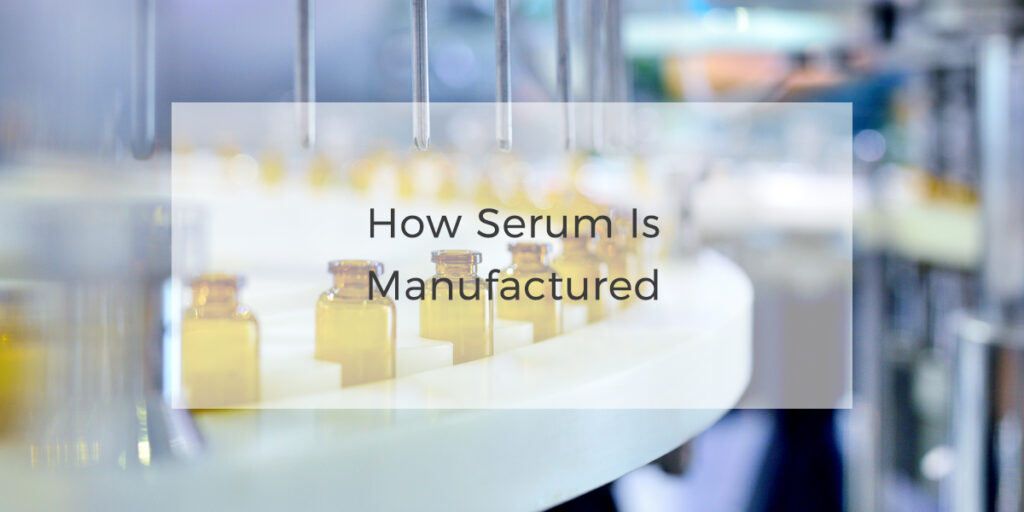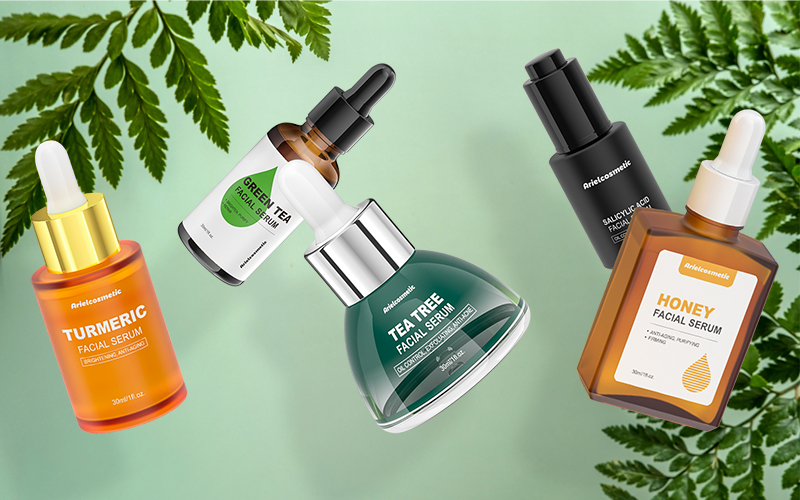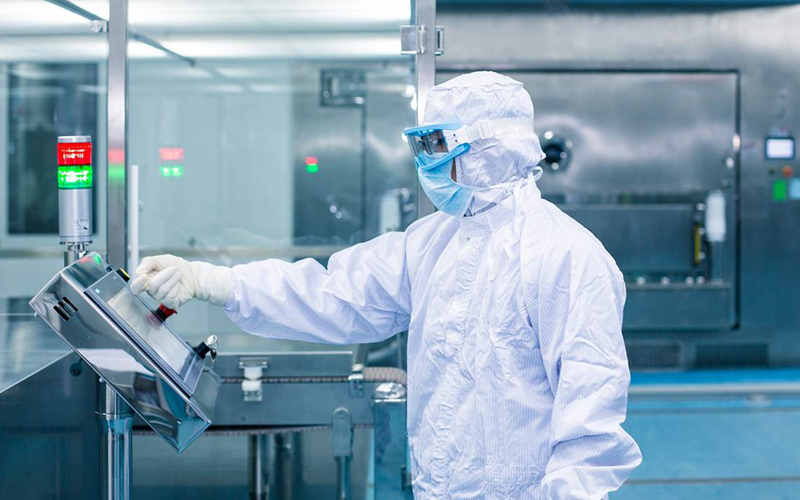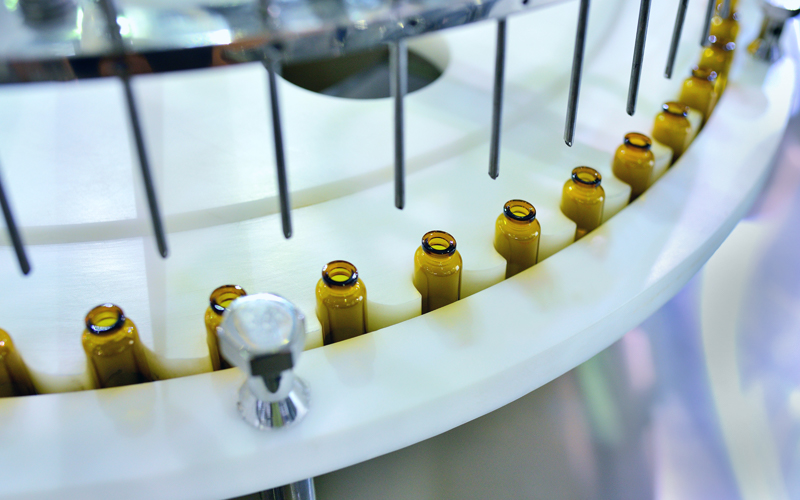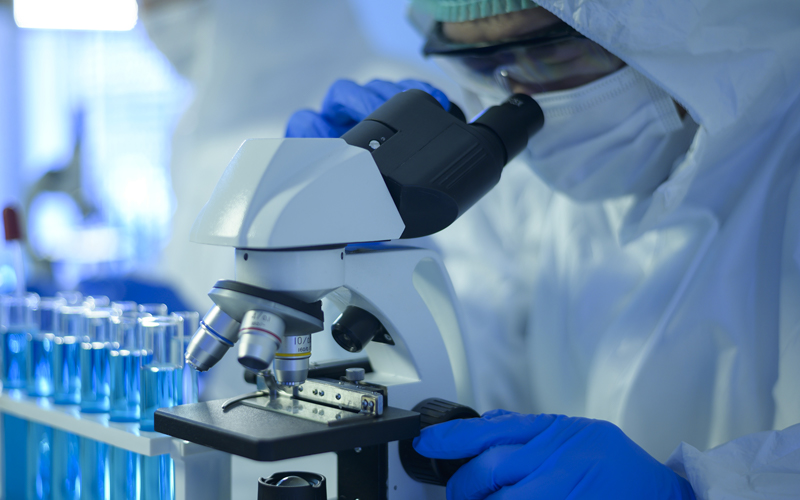Serums are highly concentrated, highly effective cosmetic skin care products that are commonly used to provide deep nourishment and repair to the skin. Next, Arielcosmetics will take you to understand the whole process of serum production:
Packaging Material Disinfection
First of all, we will classify according to the material of the packaging material. Different packaging materials have different disinfection methods. Serum packaging materials are mainly divided into two categories:
Glass bottle: high-temperature sterilization or chemical disinfection can be used. High-temperature sterilization requires the glass bottle to be sterilized in high-temperature steam. Chemical disinfection methods can use alcohol or ozone to disinfect.
Plastic bottles: Ozone disinfection, high-temperature sterilization, or chemical disinfection can be used. Ultraviolet disinfection can use ultraviolet light to irradiate plastic bottles. Still, it should be noted that the effect of ultraviolet disinfection is affected by the blocking of the bottle. The disinfection methods of high-temperature sterilization and chemical disinfection are similar to glass bottles.
Aluminum cover: high-temperature sterilization or chemical disinfection can be used. High-temperature sterilization needs to sterilize the aluminum cover in high-temperature steam. At the same time, alcohol or ozone can also be used to sterilize, but it is necessary to pay attention to the corrosion of aluminum by chemical disinfection.
Note: No matter which disinfection method is used, the packaging material must be cleaned to avoid poor disinfection effects caused by residual dirt. At the same time, after disinfection, the packaging material needs to be dried to avoid the growth of bacteria caused by moisture.
Raw Material Preparation
The raw materials required to manufacture essence include various active ingredients, moisturizers, antioxidants, emulsifiers, etc., which must be accurately weighed according to the formula. According to different formulas and functions, the raw materials of essence may be different, but in general, the production of essence requires the following raw materials:
Water: As one of the main components of the serum, water can account for most of the essence formula. Water quality greatly influences the quality of the essence, so it is necessary to choose high-quality purified or distilled water.
Active ingredients: The active ingredients in serum can be selected according to different formulas, including hyaluronic acid, vitamin C, collagen, squalane, tea polyphenols, and other ingredients. These active ingredients can provide different functions of the essence, such as moisturizing, whitening, repairing, and so on.
Stabilizers: Active ingredients in serums are often unstable and require the addition of stabilizers to maintain their stability. Common stabilizers include ethyl acid, phenoxyethanol, benzoic acid, isopropylhexanoyl gluconic acid, and others.
Solvents: Active ingredients in serums usually require solvents to dissolve them. Common solvents include propylene glycol, glycerin, polyethylene glycol, etc.
Auxiliary ingredients: Some auxiliary ingredients may also need to be added to the essence, such as emulsifiers, spices, pigments, preservatives, etc.
Note: The production of serum needs to strictly abide by the relevant regulations and standards of cosmetic production, select raw materials that meet the requirements of safety, hygiene, and environmental protection, and strictly control the production process and quality control of each step to ensure the quality and safety of the product.
Mix
The raw material mixing of the serum is an important link in the preparation of the product. The following are the general raw material mixing steps:
Preparation of raw materials: Accurately weigh the various raw materials required according to the formula to ensure that the content and proportion of each raw material are accurate.
Mixed oil phase: Put the oil or fat-soluble ingredients into a container, add an emulsifier, and stir well to mix evenly.
Mix the water phase: Mix the ingredients of the water phase well, making sure that the moisturizers, conditioners, and other ingredients are also fully dissolved.
Add the oil phase to the water phase: Slowly add the oil phase to the water phase while mixing well with a mixer until well combined.
Mixing Active Ingredients: Gradually add the required active ingredients to the above mixture while constantly stirring to ensure the active ingredients are well dispersed in the solution.
Adjust pH: Use a pH adjuster to adjust the pH of the mixture as needed to ensure it is within the proper range.
Sterilization: Sterilize the mixed product to ensure its hygiene and safety.
Note: Every step of operation needs to be strictly controlledd and monitored to ensure the quality and stability of the product. During the mixing process, factors such as temperature and stirring speed also need to be controlled to ensure that the ingredients are fully dissolved and mixed.
Emulsification
Some ingredients in serum may be oils or fat-soluble ingredients that are not readily soluble in water. These ingredients need to be emulsified to be evenly dispersed in water. Emulsification is the uniformly dispersing oil or fat-soluble ingredients in water by adding an emulsifier. Generally divided into the following steps:
Prepare emulsifier: choose an emulsifier suitable for the serum, such as polysorbate, fatty acid glyceride, lecithin, etc., and calculate the amount of emulsifier added according to the formula.
Adding oil or fat-soluble ingredients: Add the oil or fat-soluble ingredients in serum into the container.
Add emulsifier: Gradually add the prepared emulsifier to the oil or fat-soluble ingredients and stir well.
Adding the water phase: Gradually add the water to the oil phase, stirring constantly. It should be noted that adding water should not be too fast. Otherwise, it will affect the emulsification effect.
Mix well: Place the container in a blender and blend at medium speed for 20-30 minutes until the emulsification is uniform. Other ingredients, such as moisturizers, vitamins, fragrances, etc., can be added during the process.
Sterilization: The emulsified serum must be sterilized to ensure hygiene and safety.
Note: Different ingredients and emulsifiers may require different emulsification conditions, such as temperature, stirring speed, etc. Every step needs to be strictly controlled during the emulsification process to ensure the quality and stability of the product.
Filtration
In the production of serum, filtration is a very important step, which can effectively remove the impurities and microorganisms mixed in, and improve the purity and quality of the product. The following are the general essence filtration steps:
Prepare the filter: Choose a suitable filter, and choose a filter with different materials and pore sizes according to the nature and filtration accuracy of the essence. At the same time, cleaning and disinfection are required to ensure that the filter is clean and hygienic.
Filtration operation: Slowly pour the prepared serum into the filter, and gradually push the liquid pressure into the filter. Be careful not to break the filter or splash the liquid during the process.
Collect the filtrate: Through the action of the filter, impurities and microorganisms will be captured in the filter, and the serum will be filtered out. It is necessary to use a clean container to collect the filtrate to avoid secondary pollution.
Note: During the filtration process, care should be taken to maintain hygiene to avoid contamination and cross-infection. At the same time, the filtration speed and pressure should be well controlled to avoid excessive pressure damage to the filter and the impact on product quality.
Standing & Testing
In the production process of the serum, the standing and testing of the serum are very important links. Here are some common rest and detection methods:
Standing: Standing is required to separate impurities such as sediment and foam while producing the serum. The resting time depends on different essence types and production processes, usually several hours or days.
Appearance inspection: After the serum has been left to stand, its appearance can be inspected, such as color, transparency, sediment, etc. Further detection and processing should be carried out if abnormal conditions are found.
PH value detection: The PH value of the serum has an important impact on its stability and safety and should be tested. Usually, the PH value of the serum should be between 4.0-7.0, different serum types and uses may be different.
Stability testing: During the production process of the serum, it is necessary to conduct a stability test on the serum to determine its stability and shelf life under different conditions. Usually, stability testing includes heating stability, freeze-thaw stability, etc.
Microbiological testing: There may be microbial contamination in the serum, so microbiological testing is required. Common methods include colony counting method, PCR detection, etc.
Note: During the detection of the serum, appropriate detection methods and equipment should be selected, and appropriate quality control and standardized operations should be carried out to ensure the accuracy and reliability of the detection results.
Filling & Packaging
Serum canning is the last step of production. Put the prepared serum into appropriate containers and control the accuracy of canning to facilitate storage, transportation and use. The following are the general serum canning steps:
Canning equipment: The fully automatic canning equipment is used here to ensure the sanitation and accuracy of the equipment. At the same time, the canning equipment is cleaned and disinfected to avoid cross-infection.
Canning operation: Slowly pour the prepared serum into the canning equipment and gradually fill it into the tank. The flow rate of the liquid needs to be well controlled during the canning process to avoid spillage and foam.
Sealing operation: After the serum cans are filled, the cans need to be sealed to avoid secondary pollution and oxidation. We will use automatic sealing equipment for sealing.
Labeling: affix a designed label to the outer packaging of the tank, and at the same time, indicate the product name, specification, production date, shelf life, and other information. This is helpful for product traceability and management and is also convenient for consumers to choose and use.
Note: During the serum canning process, hygiene and safety should be maintained to avoid cross-contamination and improper handling. At the same time, tanks should be adequately packaged and labeled to avoid damage and confusion during transportation and storage.
Finished Products Inspection
It is also a very important link to send the packaged product to the laboratory for quality inspection. Various methods can be used to test the product’s composition, physical and chemical properties, and microbial quality indicators to ensure that the product meets relevant standards and quality requirements. Here are some common serum testing methods:
Component analysis: analyze and detect the components in the essence through chromatography, mass spectrometry and other instruments to determine the content and purity of the product.
Physical and chemical property testing: testing the physical and chemical properties of the serum, such as density, viscosity, and refractive index, to confirm whether the quality and specifications of the product meet the requirements.
Microbiological testing: The microbial quality in serum is tested by colony counting method, PCR testing, and other methods to ensure that the product meets the hygienic standard.
Stability testing: The essence’s long-term stability and thermal stability are tested to determine the quality and shelf life of the product.
Safety testing: The safety of the serum is tested through cytotoxicity tests, skin irritation tests, and other methods to ensure the product’s safety to the human body.
Note: During the detection of the serum, the hygiene and integrity of the sample should be ensured to avoid contamination and cross-infection. At the same time, appropriate detection methods and equipment should be selected, and appropriate quality control and standardized operations should be carried out to ensure the accuracy and reliability of test results.
Summary
The manufacture of serum is a process that requires complex processes such as delicate blending, temperature, and time control. It requires strict production and quality control by relevant standards and requirements. While ensuring the quality of customers’ products, we must also pay attention to production efficiency, production capacity, and cost control to create more excellent customer value.
